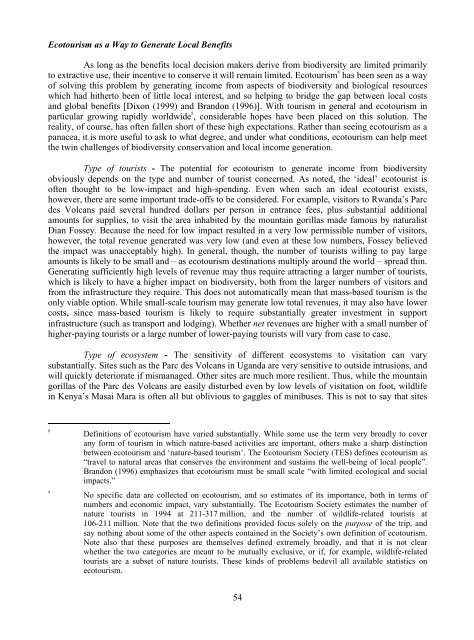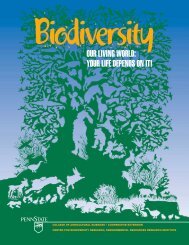Valuation of Biodiversity Benefits (OECD)
Valuation of Biodiversity Benefits (OECD)
Valuation of Biodiversity Benefits (OECD)
- No tags were found...
You also want an ePaper? Increase the reach of your titles
YUMPU automatically turns print PDFs into web optimized ePapers that Google loves.
Ecotourism as a Way to Generate Local <strong>Benefits</strong>As long as the benefits local decision makers derive from biodiversity are limited primarilyto extractive use, their incentive to conserve it will remain limited. Ecotourism 8 has been seen as a way<strong>of</strong> solving this problem by generating income from aspects <strong>of</strong> biodiversity and biological resourceswhich had hitherto been <strong>of</strong> little local interest, and so helping to bridge the gap between local costsand global benefits [Dixon (1999) and Brandon (1996)]. With tourism in general and ecotourism inparticular growing rapidly worldwide 9 , considerable hopes have been placed on this solution. Thereality, <strong>of</strong> course, has <strong>of</strong>ten fallen short <strong>of</strong> these high expectations. Rather than seeing ecotourism as apanacea, it is more useful to ask to what degree, and under what conditions, ecotourism can help meetthe twin challenges <strong>of</strong> biodiversity conservation and local income generation.Type <strong>of</strong> tourists - The potential for ecotourism to generate income from biodiversityobviously depends on the type and number <strong>of</strong> tourist concerned. As noted, the ‘ideal’ ecotourist is<strong>of</strong>ten thought to be low-impact and high-spending. Even when such an ideal ecotourist exists,however, there are some important trade-<strong>of</strong>fs to be considered. For example, visitors to Rwanda’s Parcdes Volcans paid several hundred dollars per person in entrance fees, plus substantial additionalamounts for supplies, to visit the area inhabited by the mountain gorillas made famous by naturalistDian Fossey. Because the need for low impact resulted in a very low permissible number <strong>of</strong> visitors,however, the total revenue generated was very low (and even at these low numbers, Fossey believedthe impact was unacceptably high). In general, though, the number <strong>of</strong> tourists willing to pay largeamounts is likely to be small and – as ecotourism destinations multiply around the world – spread thin.Generating sufficiently high levels <strong>of</strong> revenue may thus require attracting a larger number <strong>of</strong> tourists,which is likely to have a higher impact on biodiversity, both from the larger numbers <strong>of</strong> visitors andfrom the infrastructure they require. This does not automatically mean that mass-based tourism is theonly viable option. While small-scale tourism may generate low total revenues, it may also have lowercosts, since mass-based tourism is likely to require substantially greater investment in supportinfrastructure (such as transport and lodging). Whether net revenues are higher with a small number <strong>of</strong>higher-paying tourists or a large number <strong>of</strong> lower-paying tourists will vary from case to case.Type <strong>of</strong> ecosystem - The sensitivity <strong>of</strong> different ecosystems to visitation can varysubstantially. Sites such as the Parc des Volcans in Uganda are very sensitive to outside intrusions, andwill quickly deteriorate if mismanaged. Other sites are much more resilient. Thus, while the mountaingorillas <strong>of</strong> the Parc des Volcans are easily disturbed even by low levels <strong>of</strong> visitation on foot, wildlifein Kenya’s Masai Mara is <strong>of</strong>ten all but oblivious to gaggles <strong>of</strong> minibuses. This is not to say that sites89Definitions <strong>of</strong> ecotourism have varied substantially. While some use the term very broadly to coverany form <strong>of</strong> tourism in which nature-based activities are important, others make a sharp distinctionbetween ecotourism and ‘nature-based tourism’. The Ecotourism Society (TES) defines ecotourism as“travel to natural areas that conserves the environment and sustains the well-being <strong>of</strong> local people”.Brandon (1996) emphasizes that ecotourism must be small scale “with limited ecological and socialimpacts.”No specific data are collected on ecotourism, and so estimates <strong>of</strong> its importance, both in terms <strong>of</strong>numbers and economic impact, vary substantially. The Ecotourism Society estimates the number <strong>of</strong>nature tourists in 1994 at 211-317 million, and the number <strong>of</strong> wildlife-related tourists at106-211 million. Note that the two definitions provided focus solely on the purpose <strong>of</strong> the trip, andsay nothing about some <strong>of</strong> the other aspects contained in the Society’s own definition <strong>of</strong> ecotourism.Note also that these purposes are themselves defined extremely broadly, and that it is not clearwhether the two categories are meant to be mutually exclusive, or if, for example, wildlife-relatedtourists are a subset <strong>of</strong> nature tourists. These kinds <strong>of</strong> problems bedevil all available statistics onecotourism.54












